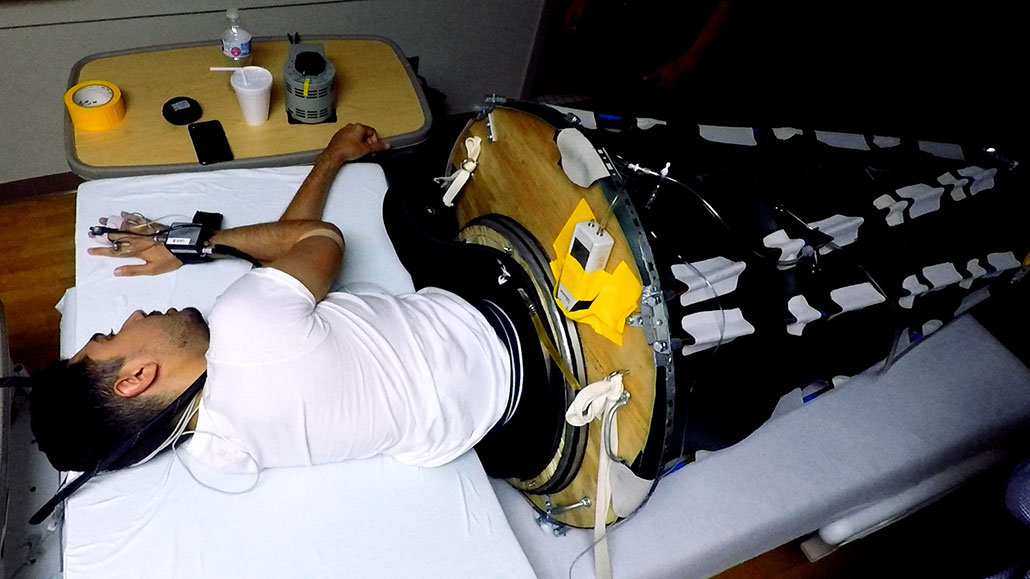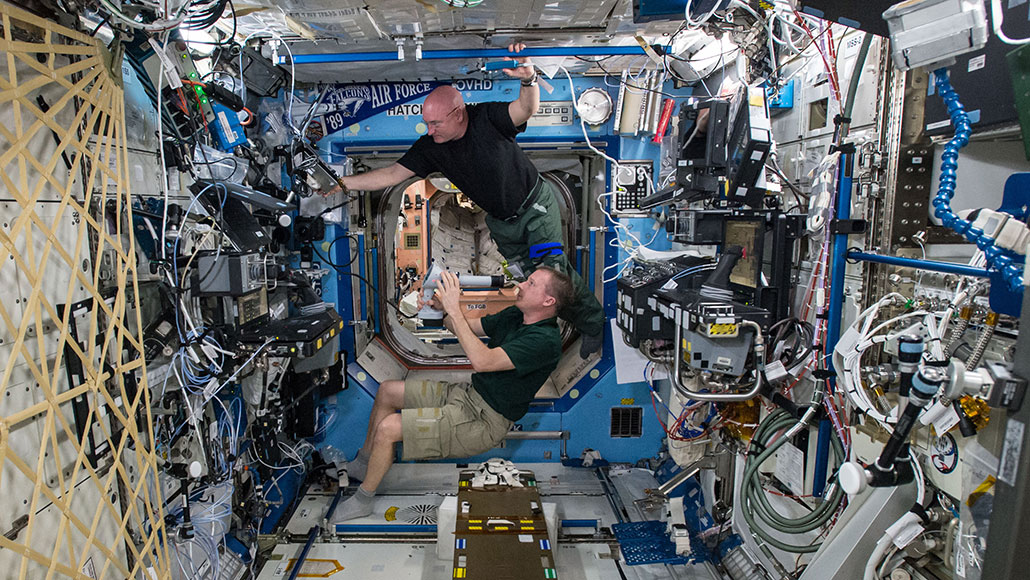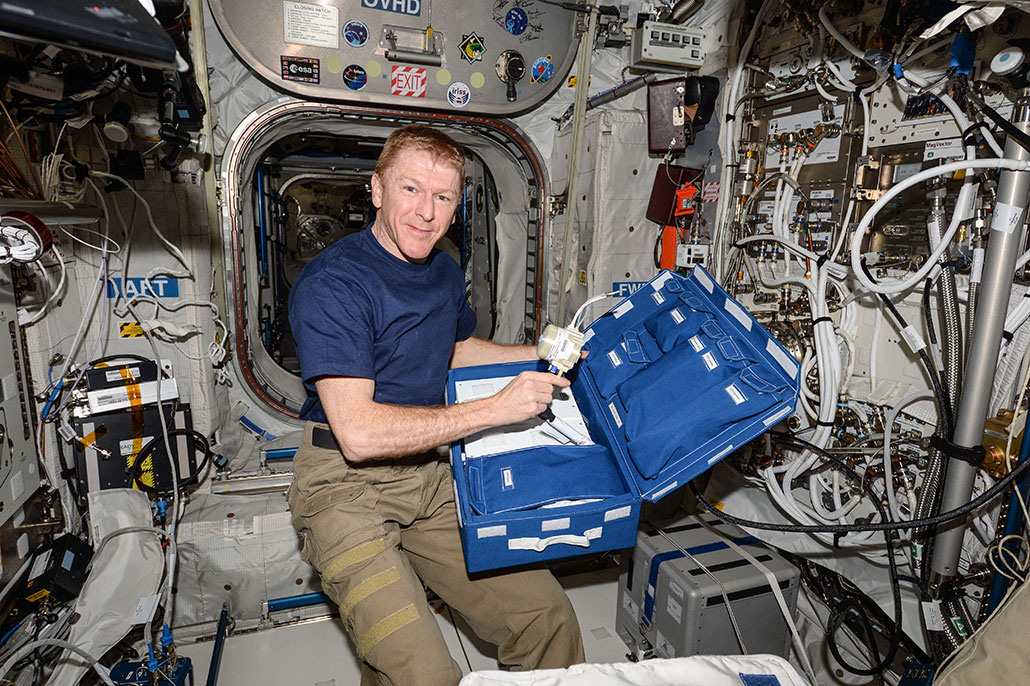Here’s how a new sleeping bag could protect astronauts’ eyesight
Its design aims to counter pressure on eyes from long periods spent in microgravity

Study co-author James Leidner, a medical doctor, spent three nights in this high-tech sleeping bag. The invention eases pressure that can be caused by a fluid buildup behind the eyes. During long space flights, that pressure can lead to vision problems.
UT Southwestern Medical Center
A new sleeping bag could prevent vision problems on long space missions. The invention aims to relieve pressure that builds up behind the eyes during long periods of low gravity. Astronauts experience this microgravity in space.
The high-tech sleep sack looks like a giant sugar cone and covers only the lower half of the body. The idea for it came from a technique scientists use to study blood pressure, notes Christopher Hearon. He’s a physiologist at the University of Texas Southwestern Medical Center in Dallas. He and others described their new invention in JAMA Ophthalmology on December 9, 2021.
The sleeping bag’s design aims to avoid something known as SANS. That stands for spaceflight-associated neuro-ocular syndrome. On Earth, gravity pulls fluids in the body down into the legs. But without the pull of Earth’s gravity, too much fluid stays in the head and upper body.
This extra fluid “presses on the back of the eye” and changes its shape, explains Andrew Lee. He was not part of this study. As a neuro-ophthalmologist (Op-thuh-MOL-uh-gist), he’s a medical doctor who deals with the nerves in the eye. He works at Houston Methodist Hospital and at a new Weill Cornell Medical College program. Both are in Texas.
“You get more far-sighted,” Lee explains. The pressure also causes a part of the eye’s optic nerve to swell. “Folds can form in the back of the eye as well. And the extent of the effects depends on how long people spend in microgravity. “The more time people spend in space, the more fluid stays in the head,” Lee says. “So a long-duration space flight — like 15 months — could be a problem.” (That period is how long it would take to get to Mars.) Lee and others described SANS in npj Microgravity in 2020.
And here’s where Hearon and his team enter the story. Earlier studies on blood pressure used methods that sucked out air to create negative pressure around the lower body, Hearon says. Some groups had tried to harness that concept to prevent SANS. But they ran into challenges, Hearon notes. So his team decided try an approach that would treat astronauts when they weren’t working. That’s why bedtime seemed ideal.

Their innovation
The team knew that tucking someone into a regular sleeping bag and sucking out air wouldn’t work. At some point the bag would collapse and press against the legs. That would backfire, pushing more fluid into the head. “You really need to have a chamber,” says Steve Nagode. He’s a mechanical and innovation engineer in Kent, Wash. He began working with Hearon’s crew while he was with REI, a sporting-goods company.
The sleeping bag’s cone gets its structure from rings and rods. Its outer shell is heavy vinyl, like that used on inflatable kayaks. The seal around the sleeper’s waist is adapted from a kayaker’s skirt. (The snug fit keeps water out of a kayak.) And a platform like a tractor seat keeps an astronaut from being sucked in too far when the device’s low-power vacuum is on. “You feel like you’re getting sucked into the sleeping sack a little bit,” admits Hearon. “Otherwise, it feels really normal once you get settled in.”
His team tested a prototype with a small group of volunteers on Earth. “We had 10 subjects who each completed two bouts of 72 hours of bed rest,” he explains. At least two weeks separated each three-day test period. Except for short bathroom breaks, the volunteers stayed flat. Earlier research had shown that was enough time to cause fluid shifts like those astronauts would experience.

The volunteers spent the three days in one test session laying normally in bed. They stayed on the same bed for three days in the other test session. But their lower body was in the sleeping sack for eight hours each night. During each test period, medical personnel measured heart rates and other things.
They measured blood pressure, for instance, as blood fills the heart. Known as central venous pressure, this CVP is high when there’s a lot of blood in the upper body, as happens in space. CVP also went up when people stayed flat. But it came down at night when the sleep sack was on. That “confirms that we were pulling blood down to the legs, away from the heart and head,” Hearon says.
People’s eyeballs also showed tiny changes in shape when they stayed flat on the three days that they didn’t use the device. Shape changes like those are an early sign of SANS. The changes were much smaller when people used the device.
Lee at Weill Cornell and Houston Methodist says he hopes the design would prevent SANS in microgravity, but “It might not. We don’t know because we haven’t tested it in space.” He also wonders about possible side effects from longer-term use. It’s one thing to reverse changes in fluid pressure, Lee says. “It’s another thing to do it safely.”
Hearon and his group agree more testing is needed. “Missions are going to be much longer than three days,” he notes. Future work also will explore how long the device should run to give the best results.
Nagode may also draw on his skills from designing backpacking gear to make future tweaks. The team may want to make the cone shape collapsible, for example. After all, he says, “Anything going up into space has to be lightweight and compact.”
Credit: UT Southwestern Medical Center
This is one in a series presenting news on technology and innovation, made possible with generous support from the Lemelson Foundation.







